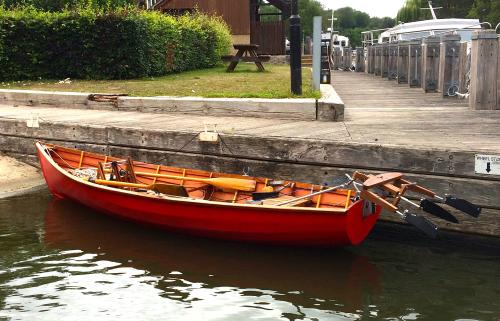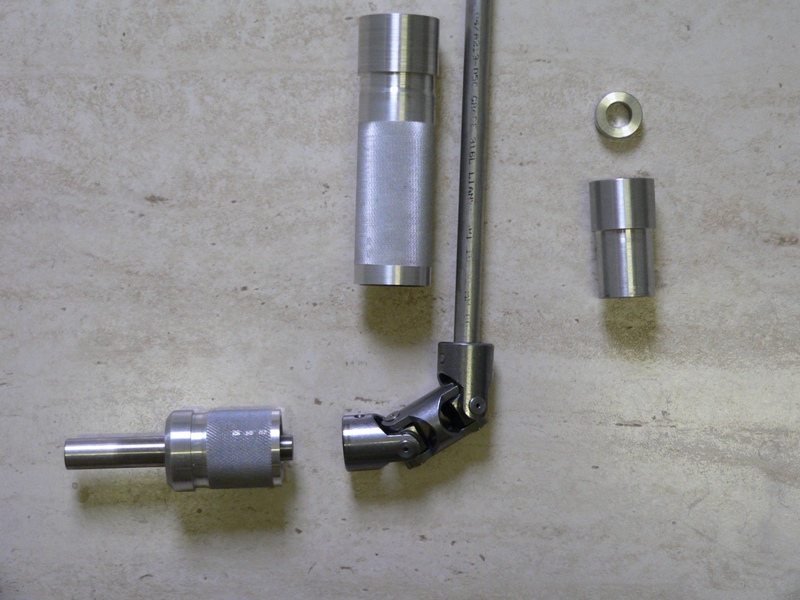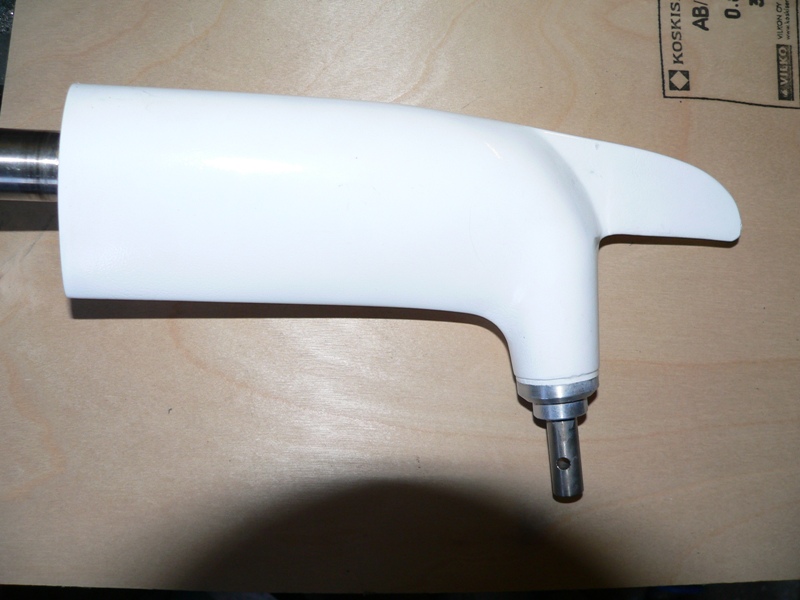Pedal fin propulsion for small boat
12
12

|
Paul H (admin) |
Re: Pedal fin propulsion for small boat
|
|
Alan,
It looks well built, the wood and bolts will be strong. The blade tubes obviously take most strain, but they can be upgraded. Good luck with trials. Paul |
|
|
The GRP tubes for the fins were replaced with solid aluminium so they will be ok. But I have to report that the boat was launched and tested yesterday and was extremely disappointing. Very little thrust, very little steering response (possibly due to the low speed) but also very easy to operate, so I can only assume that the fins are not doing much work. They could be twisting far more than I expected or they may not be moving far or fast.
If my boat didn't have a structural keel and a fabric skin I would be much better off with a proper mirage Drive! Pictures show the device tilted, and backrest folded to enable rowing; and trim when in the water. Looks about the right depth.  
|
|
|
Regarding steering, I’m wondering whether water pushed sideways at the rudder by the fins is messing with the steering effect.
A video of the fins in motion (out of the water initially) might help see what’s stopping them delivering. Though I’m not entirely clear just how the Mirage drive works so well.
The main difference I can see between the original drive and your system is that the drive pivots the fins just at the top of the blade, so the tips swing through a wide arc and the top of the blade hardly at all. This corresponds with the tips being where
the blade flexes most. Not sure if that observation is in any way pertinent!
Sent from my iPad
On 17 Jul 2020, at 12:12, Alan [via UK HBBR Forum] <ml+[hidden email]> wrote:
|
|
|
The top of the fin can move from side to side (tacking) restrained between two points. Hobie calls this the clew area. I found a video which clearly shows this area and my fins "tack" through almost exactly the same angle. I also found that the twist is reduced by lengthening the "mast";it has a screw in the end which is unscrewed a bit to extend it. These two features are just like an upside down mainsail - the tacking angle is like having the mainsheet to a traveller which has adjustment for the distance that the slide moves, and the twist is controlled by tightening the kicker. So I can adjust these two variables.
Then I can increase the angle of travel of the fins, and also attach the strings closer together on the yoke for even more travel, at the risk of fins clashing with the rudder. So all is not lost, I hope I can get this done while I still have a weekly license for the Medway. Tim, the fins are not affected when you move them in air, but if I could rig a camera over the stern that would probably help. |
|
|
Another 60 mile round trip to the Medway to try the revised Contrapyuloh Recreational Aquatic Propulsion system, and after all the revisions it certainly lives up to it's acronym. Speed has increased from 0.5Kt to 0.75Kt. But while I was there I got talking to a chap with a fishing kayak with a knock-off Mirage Drive (with bevel gears instead of cables) and he kindly offered to send me a spare set of his fins, which are like the original MD fins, which he has done. So I have ordered some stainless rod which will become the masts. Meanwhile, I will make some larger fins.
But I tasted my first ripe wild blackberries today! |
|
|
I have not tried the knock-off hobie fins that were given to me yet because of the difficulty of making a mounting system which is compatible with these and my own new fins. So, I've made some new and larger fins similar to photo earlier in this thread and also added a system to allow adjustment of tacking angle.
I took the contraption and boat down to the Medway again today and can report that it works better than previous attempts but does not remotely match rowing, so I'm giving up! While searching Youtube I came across a video of the inventor of the Mirage Drive showing a very early prototype working very well. It had fins strangely like mine - fabric with a foil section and apparently not much twist; so I'm baffled as to why my device is ineffective and the MD works so well. I've made plenty of successful model planes, model yachts, carved propellers etc. but can't make a flappy fin! Time to hand it over to the AYRS....? |

|
Paul H (admin) |
Re: Pedal fin propulsion for small boat
|
|
Alan,
How about taking an underwater video of Timmo's MD drive, that works extremely well? Comparing, it might be obvious what is different about your fins. -Paul |

|
Port-Na-Storm |
Re: Pedal fin propulsion for small boat
|
|
I must admit that I have been a bit confused about the action of your fins Alan. On the mirage drive they can move in an arc approaching 180 degrees. There is a YouTube video here. It doesn't look as though yours can move anywhere near that amount, although I appreciate yours are sweeping in a wider arc due to the longer arms. Given that the fins have to "tack" at the end of each sweep there isn't much left to put the power on. Probably a combination of factors, including sweep, Hull hydrodynamics, weight etc are combining to reduce efficiency. Sterling effort though, its great to see someone having a go. Graham Sent from my Xperia by Sony smartphone ---- Paul (admin) [via UK HBBR Forum] wrote ---- Alan, How about taking an underwater video of Timmo's MD drive, that works extremely well? Comparing, it might be obvious what is different about your fins. -Paul If you reply to this email, your message will be added to the discussion below:
http://uk-hbbr-forum.967333.n3.nabble.com/Pedal-fin-propulsion-for-small-boat-tp4031477p4031715.html
To start a new topic under Builds in Progress, email [hidden email]
To unsubscribe from UK HBBR Forum, click here. NAML |
|
|
The Mirage drive is certainly a clever piece of kit, Hobie don't seem to want to share precisely what makes it work so efficiently. There is an element of birds wing about it. The broad end of the blade nearest the pivot moves significantly slower
and a lesser distance through the water than the tips of the blades. The tips also flex a great deal more than the broad part of the blade. How and why that should impact on performance I don't really understand (any resident scientifically minded contributors
could help here, Jeremy? John? other?) but it seems to be the main difference between Alan's rig and the original Mirage Drive operation.
im
|

|
Port-Na-Storm |
Re: Pedal fin propulsion for small boat
|
|
This post was updated on .
Can't help thinking those birds might be penguins.
https://youtu.be/VKDR2EV_UCE G Sent from my Xperia by Sony smartphone |

|
Paul H (admin) |
Re: Pedal fin propulsion for small boat
|
|
In reply to this post by Port-Na-Storm
Alan,
Three observations: The Mirage has one horizontal axis, below the water, for both blades. The Mirage blades move through 180 degrees, as per Graham's video link. The Mirage blades are stacked closely. Your device has two horizontal axes, about 1ft out of the water, hence your blade locus is very different to the MD. Your blades don't sweep through 180 degrees. My suggestion is to engineer a scale clone of the Mirage drive (one axis below water, 180 sweep), and drive it with remote pedals. -Paul |
|
|
In reply to this post by Timmo
Looking closely at the way that the Mirage blades twist and rotate, it seems as if they are operating rather like oscillating propeller blades. There's certainly a lot of twist on each blade, that changes sense when the blade changes swing direction.
They seem to work rather like a sculling blade, except in that case the blade twist is induced by the natural rolling action of the wrist. I've not looked closely at how the Mirage blades are fixed to the drive, or what induces the twist that's evident in the underwater video shots, but I think that close examination of a drive should show how that's induced. Nothing wrong with making a copy of that mechanism for personal use, I believe, I think you only get into trouble by trying to sell something that infringes their patents. I think the way the blades are designed, such that the tips washout, is to try and keep the lift (really the propulsive force) the same along the length of each blade, despite the change in velocity due to it swinging about a pivot. There's probably an efficiency loss in doing this, but, like a propeller, it's a compromise that's acceptable in order to keep the mechanical linkage a bit simpler. In theory, a pair of blades (to offset any turning force) arranged to travel with a linear side to side motion at the stern, and with a fixed angle that changes sense at each change of direction, might be more efficient. Getting the mechanical linkage right to work such a system would be a challenge. The system that I thought had a lot of promise, was the stern-mounted prop drive, driven by a loop of wire, running via two pedals and a couple of one-way bearings, like this (I was given consent by the originator to post these ages ago, BTW):  The idea was adapted further to make a prototype outboard drive, like this:  Somewhere I have a video clip of this drive working, showing how it turns the reciprocating motion from the pedals into continuous rotation at the prop. The efficiency was reasonable, not as good as a direct shaft drive using bicycle type pedals, but not far off. The outboard drive version was intended to be able to steer the boat and to tilt up out of the water. The only issue was the lack of any ability to go astern, but that was a limitation on the original Mirage drive, too (although not on the later version). I wasn't that comfortable with the way Rick put the sprag bearings under water, although they were stainless steel, IIRC. At the time I was thinking of doing something similar, but having the shaft run vertically down the leg, with the sprag bearings at the top, clear of the water. I was planning on using the double universal joint system I used on the duck punt electric drive system to turn the prop through 90 degrees, as that works very well, and is pretty efficient:   |
|
|
This post was updated on .
In reply to this post by Paul H (admin)
Thanks for your comments gents. Greg Ketterman, the inventor of the mirage drive was strongly influenced by the motion of penguin wings/fins. I would say they operate more like the wings of a hovering humming bird - same 180 degree movement, same extreme twist. My fins sweep through about 60 or 70 degrees - they meet in the middle, but they probably sweep the same or greater area per stroke than the MD. Both mine and the MD have to tack at the end of each stroke.
The MD does have a few built-in advantages; the hull acts as an end plate and when the fins cross in the middle the efficiency increases as the front tip vortex helps to reduce the rear tip vortex. And as an extra excuse for me, my fins work near the surface so that might be a slight disadvantage. Second edit: I like the idea of the one way clutches at the top of a vertical shaft and double UJ. But having carefully arranged all the strings through fairleads, two to operate the device, one to lift it and potentially another to control blade twist on the fly, I no longer much like the strings or wires hindering space in the boat. So I'm casually, but not yet seriously thinking of a surface drive propeller and conventional pedals. I have a suitable bevel gearbox and the shafts would be at floor level and might just fit around the aft battery, leaving electric power as an option. I suppose I could even drive the same propeller with an electric motor. Third edit: The original Hobie patent has long since run out but they have later ones to cover developments like the 180 (reversing), pop up fins after hitting an obstacle and others. |
|
|
Alan - Sorry to hear that your device does not work well, I can't imagine why not since I have seen that the one made by Chris Waite does work and also your device is not a lot different in principle to an ordinary sculling oar. There are a couple of things I could sugest.
One point is that for single oar skulling the operator can feel the force the blade is applying to the boat and the operator probably, and perhaps sub-consiously, adjusts the exact angle and trajectory of the blade to more or less maximise this force. A simple mechanical system lacking such brain power may or may not achieve this, perhaps the Hobie people have got it right whereas you may need to keep trying. If you are relying on the flexibility of the blade to provide the correct angles that may be quite critical. Another point is that the part of any hydrofoil operating close to the surface, say within a couple of chord widths from the surface, seems to be rather ineffective as was shown by some of the laboratory tests of hydrofoils dating back to the 1930's when hydrofoils were being investigated as a possible way to make an undercarriage for a seaplane. A possible exception might be the surface piecing propellers on some fast motorboats, these obviously do work which seems strange to me. The reduction of lift as a hydrofoil gets close to the surface probably does much to help many hydrofoil supported boats to maintain a reasonably steady height. I wonder if your fins are deep enough that there is enough area reasonably well submerged. The AYRS has been holding Zoom meetings recently, I think that has been quite successful although only a fairly small fraction of the AYRS membership has yet participated. All are welcome so if you were to come to these meetings we could discuss your project there - Alastair Law quite often attends these meetings and he uses a yuloh to good effect. The next two AYRS Zoom meetings are on Saturday 12 September and Saturday 10 October, both at 19:30BST, details at ayrs.org. I note that you are considering trying a 'surface drive propeller' on your boat. I recall seeing somewhere on the internet an interesting pedal powered propeller used as auxiliary propulsion on a large catamaran. This was a large diameter, I think at least 1200mm diameter, with two quite narrow blades which means that at least the outer parts of the blades would be quite deeply submerged some of the time. The propeller hub was at water level so only one blade at a time would be in the water. It turned slowly with a straght through direct shaft drive to foot pedals, the operator sitting transverse to the fore and aft axis of the boat which makes for a simple mechanical arrangement. It was reported to work well on a much larger craft than would normally be powered by only human power. |
|
|
Here is a propulsion idea that I really like; it's what I'm calling a Wells propeller because it's like the Wells turbine but in reverse. A Wells turbine, invented by a professor of that name always rotates in one direction no matter which way water flows through it, as the blades tack. This propeller thrusts in one direction even though it rotates in both directions. It might be worth me putting the strings and pedals back in the boat. I note though that later versions have conventional pedals and propeller.
https://www.youtube.com/watch?v=NCvVCzqeOic |
|
|
That looks interesting, not seen it before. Less complex in some respects than the Mirage Drive, certainly could be an easier idea to adapt to a stern drive system. Will be interested in your ongoing experiments.
Sent from my iPad
On 21 Aug 2020, at 17:39, Alan [via UK HBBR Forum] <[hidden email]> wrote:
|
|
|
PEDAL/FIN CONTRAPTION AVAILABLE.
I can let go of this device now so if anyone wants it to experiment with it is available now, with a couple of fins, rudder and pedals although the pedals really need their wood sides replacing with aluminium for more strength. Free but does not include the outboard tilt/clamp assembly. It could be mounted to a transom with four stand-offs which would mean drilling four holes in the transom. I will pass on this information to the AYRS chaps. |
«
Return to Builds in Progress
|
1 view|%1 views
| Free forum by Nabble | Edit this page |


